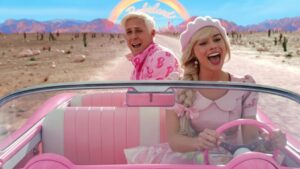 Desperately searching for a column idea, I discovered that this summer’s blockbuster movie was opening right here in Cookeville on a blazing hot Friday afternoon. Why not relax inside the air-conditioned Highland 12 Cinema and see if it lived up to the hype?
Desperately searching for a column idea, I discovered that this summer’s blockbuster movie was opening right here in Cookeville on a blazing hot Friday afternoon. Why not relax inside the air-conditioned Highland 12 Cinema and see if it lived up to the hype?
I’m not talking about “Oppenheimer,” which I plan to see soon. And I’m not talking about “Sound of Freedom,” which I’ll skip. I saw “Barbie,” an unlikely choice for someone who never owned or even played with the world’s most iconic toy. (While doing research for this column, I learned that Barbie is the most recognizable item on earth, more so than even Coca-Cola. Wow.)
I was not quite five years old when Barbie burst onto the scene in 1959. Her inventor, Ruth Handler, came up with the radical and brilliant idea that little girls might enjoy playing with dolls that looked like adults rather than baby dolls. My mother, who until her dying day couldn’t understand why I didn’t like dolls, declared that Barbie was better suited for teenagers than girls my age so I wouldn’t be getting one any time soon. Throw me in the briar patch.
Decades passed. I became the mother of two little girls who adored Barbie (and one little boy who preferred Teenage Mutant Ninja Turtles). Our house was filled with boxes and bins of Barbie dolls and an absurdly large assortment of Barbie clothes and accessories. I was okay with that. Barbie kept my daughters busy and happy. And they learned early on that, while I would say yes to playing cards or board games or basketball with them, my answer to playing Barbies was no thanks.
I didn’t dress in pink sparkles to attend the movie premier. I didn’t know I was supposed to. But lots of people did. Pink hats and t-shirts and tutus. Pink hair bows. Pink high heels. Pink jewelry. I was almost sorry when the lights went down and I couldn’t continue to check out what everyone was wearing.
“Barbie” is a bubblegum pink movie, for sure. That’s one of the most fun things about it. And fun is, I think, the key word when it comes to this movie. Those who view it as serious social commentary are missing the point. The story goes like this. In Barbie Land, the women–all of whom, except for pregnant Midge, are named Barbie–run everything. These Barbies come in many sizes, shapes and colors and hold every kind of job imaginable. (After all, Barbie has had more than 250 careers, from astronaut to doctor to firefighter, in her long life.) They’re busy. They’re competent. Most of all, they’re happy. There are men in Barbie Land, too. With the exception of Allan, they’re all named Ken and serve no other purpose than eye candy.
When Barbie experiences an existential crisis and is transported, along with her own special Ken, who’s hiding in the back seat of her Barbie car, from her perfect plastic world to the real world, she’s shocked and confused. It’s a patriarchal society where men control everything. Barbie is devastated. Ken is delighted.
I won’t tell the rest of the story, but I will say the plot has plenty of holes and is kind of hard to follow. That’s okay. The movie’s message shines loud and clear. Being a woman is messy and complicated. Women should value and support one another. Women can do anything they set their minds to. And the casting is brilliant. I can’t imagine anyone in Hollywood more perfectly suited to play Barbie and Ken than Margot Robbie and Ryan Gosling. Or to play Ruth Handler than Rhea Perlman.
Is “Barbie” a story for the ages? Definitely not. But there are surely far less satisfying ways to spend a couple of hours on a hot summer afternoon than going to the movie theatre to see it.
(July 29, 2023)